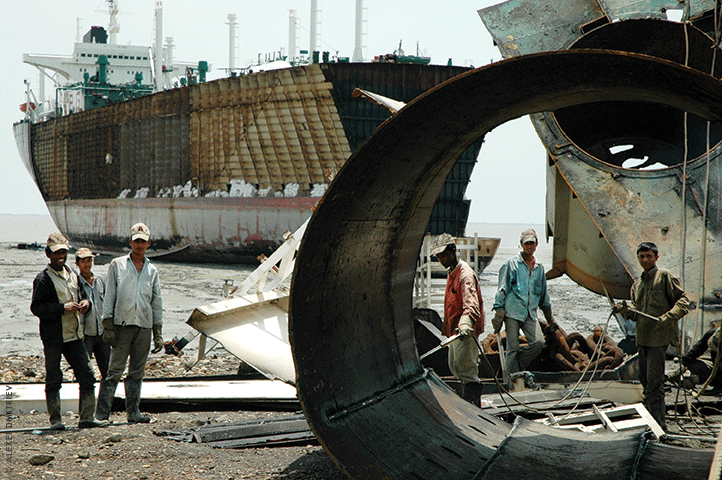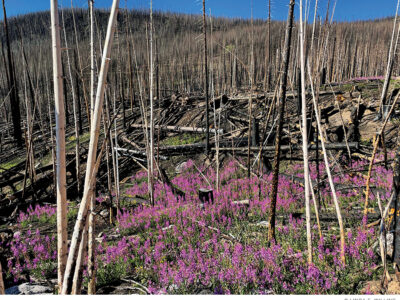
Among the ship-breakers of eastern Bangladesh.
By Alexei Dmitriev | On the edge of Sitakunda, a tiny village not far from Chittagong on the main road to Dhaka, the typical sights of rural Bangladesh give way to an unusual cluster of shops. For about a mile, maritime bric-a-brac overflows the premises of one ramshackle building after another, in such profuse variation that it would captivate anyone from a quirky collector of ship paraphernalia to a frugal landlord on the lookout for cheap sinks and toilet bowls.
“We have a sale on freezers and life-jackets,” said a shopkeeper, enticing me into his second-hand wonderland. Rows of compasses crowded shelves pushed against walls choked with clocks. Entire rooms bristled with brass parts sold by weight. Ship freezers were large enough to house an average-sized Bangladeshi family. The orange mountain of lifejackets rose near a flotilla of lifeboats that could have saved a Pacific island nation from rising ocean levels.
As my driver turned onto an unpaved country road a bit further on, we passed through a sleepy village where a barber froze above a foamed-up client surprised to see my pale face. Then the surreal scene revealed itself. Hovering over a landscape of rice paddies fringed by palm trees loomed the alien superstructure of a huge cargo freighter. And another one, and another… as if the steel ogres had just sprung up after the latest monsoon and smart farmers had figured out how to tame them and harvest a hefty crop.
In Sitakunda dead ships can yield much more than planting crops. We were approaching a graveyard: a 20-mile stretch of beach where ships go to die and thousands of men vie to be their undertakers.
When ships get old, rarely do they end up as artificial reefs for the enjoyment of divers. Instead they are sold through intermediaries to ship-breaking yards for about $12 per ton of lightweight tonnage. The captain of a condemned ship will wait for high tide and for the last time order “full steam ahead” towards the Sitakunda beach. With a blood-curdling sound the vessel will scrape the bottom and finally come to a stop a few yards before the surf line. The crew will drop anchor, shut the engine, and kill the lights from bow to stern. Then they climb down a rope ladder into a dinghy leaving behind the corpse of a vessel and head to the nearest airport for a flight home.
Like any other graveyard, Sitakunda functions as a great equalizer. The white cruise ships where kids’ shrieks recently echoed over the pool come to rest next to trawlers whose rusty hulls still reek of fish. Nobles and commoners meet their fate side by side. They line the shore as far as the eye can see, and as the hot air quivers on the horizon some of them appear to be moving. It is an illusion, of course, for this beach is their final port of call.
Every morning a rugged army of workers emerges from a shantytown built from ship refuse. Men stream onto a beach awash in the low sunlight. They climb and inundate a new arrival like an industrious army of ants. They comb through living quarters looking for abandoned food, cigarettes, and the most precious trophies in an Islamic country—the pornography and alcohol stashed under sailor’s berths.
For the next few months, armed with hammers and acetylene torches, they will take the ship apart, stripping it layer by layer like an onion. They inhale asbestos and other poisonous fumes, treading over razor-sharp debris in flip-flops. On average, according to a Greenpeace Report, one of them is killed every week and one is wounded every day in an accident or explosion. The 200 taka daily pay ($2.50) that helps their families to stay afloat in remote villages, however, makes it worth it for the estimated 35,000 people who work in the Sitakunda ship-breaking yards. It is an important industry for Bangladesh, which gets 60 percent of its steel from scrapped ships and where more than 300,000 people get employment in related industries.
Decommissioned ships were once taken apart in the industrialized countries where they were built. The process required a dry dock, hefty cranes, and other expensive machinery. Environmental regulations and the demands of organized labor amplified the costs. So in the 1970s, ship-breaking moved to Korea, China, and Taiwan. But as these countries’ economies came to rival those in the West, they switched from taking ships apart to building them. That is when Providence shone on Bangladesh: a strong cyclone beached a merchant vessel in Sitakunda, and enterprising locals soon took it apart literally with their bare hands. A new center of the ship-breaking industry was born.
Though for a time Sitakunda welcomed curious tourists, the operators now dislike nosy foreigners, especially those toting a camera. For all they know, I could be a Greenpeace activist aiming to raise a stink about the tons of deadly chemicals polluting the beach and seeping into the ocean. Or an International Labor Organization spy seeking evidence of child labor and neglect for elementary safety measures. But my contacts in Dhaka made calls to the right people in Chittagong.
“He’s OK,” they vouched for me. “He’s Russian. His country did and does worse things to its own people and environment.”
So the barbed-wire gates opened and I entered the domain of PHP Ship Breaking and Recycling Company. The PHP stands for Peace, Happiness, Prosperity.
There, Mr. Hassan, a foreman tasked with being my handler, tried to translate the chaotic scene into order.
“We start by drilling holes in the hulk to prevent the explosion of fuel vapors that may get pent up inside. Then we cut up the superstructure that has been stripped of all valuable instruments and copper piping and wiring.”
The superstructures are cut into portions as big as a single-family American home. The earth shakes when they crash into the mud. The giant pieces are then hauled ashore by a diesel winch.
“The workers know that frayed cables can snap, but it is ‘not cool’ to move away to safety,” said Mr. Hassan with a fatherly concern.
Work slows down for the hull, which is built to prevail in high seas and does not succumb easily to hammers and torches. But the poor can’t be bashful: they attack every rivet of the bow, gradually opening the maze of bulkheads inside and making their way into the engine room.
“Most times the engine is worn and will be taken apart for scrap,” Mr. Hassan told me. “However, the bronze propeller alone can bring in $50,000. The rudder is the last thing to be cut, it is like a tradition.”
“This is my seventh year here,” a worker named Badrul Islam told me under Mr. Hassan’s watchful eye. “My job is to scoop the used oil from the engine and pour it into barrels.” Mr. Hassan quickly added that nothing gets wasted: 98 percent of the ship gets recycled. The remainder—asbestos, arsenic, mercury, PCBs, cadmium, and God-knows-what other hazards —is washed away by the waves, soaked up by the Sitakunda sand, or absorbed by Badrul Islam’s blackened hands and feet . In a country overrun by poverty, there is no shortage of men willing to take his place.
“We are doing as much as we can for the workers. We have been in this business for decades and we learned to stay competitive,” Mr. Hassan told me, in response to my question about whether PHP remains true to its acronym. About 15 years ago, the fuel tank of an Iranian tanker exploded, burning 16 people to death and injuring 52. Since then safety standards have improved, according to Arifur Rahman from Young Power and Social Action (YPSA), a NGO that monitors the industry in Bangladesh, but the yard owners are still known to cover up injuries and deaths. I later realized why some workers looked at me with concern: the media normally visit after a deadly accident. At other times nobody cares much about the living in Sitakunda.
Later, in the shantytown, I noticed a few crippled men. “I can’t go back to my village and be a burden for my family. Here I can sometimes get work as a watchman,” one of them told me, speaking through a canteen owner who translated. In five minutes the workers rushed in for lunch and I also got my serving of rice, dhal, and a chapati for the equivalent of 20 cents. I watched a cherubic youngster with a welder’s mask by his side expertly scoop a banana leaf clean with his hand. When the workers were gone, the canteen owner told me that the boy was 15 and had been employed for three years. Noticing the consternation on my face, he said: “If parents can’t provide for their children, they will be forced to work. If not here, then somewhere else, and it may be worse.”
When, in 2009, the Supreme Court of Bangladesh considered closing down ship-cutting companies that lacked proper licensing from environmental authorities, 10,000 workers lined up on the Chittagong-Sitakunda road in protest. According to knowledgeable Bangladeshis I talked to, the industry would not survive the restructuring needed to pull it closer to Western standards.
“Those in the West who are up in arms against inhumane conditions have to decide on a choice: to let the workers die from hunger now, or let them die from asbestos later, having helped put their children through school,” said my friend Mozammel “Babu” Haque, a TV journalist here.
I found it difficult to dismiss his point. The workers I saw were dirty and poor by most standards, but they did not have the look of desperation and supplication of the street beggars that populate every corner of Bangladesh. They looked me in the eyes as equals and smiled.
It seemed obvious that they would greet the next ship to beach here with cheers, not groans. Two dozen sinewy hands would lift a ton of steel and, walking barefoot in small steps like pall bearers, carry it through the surf to nearby lorries emblazoned with colorfully painted birds of paradise, as is customary in Bangladesh. Their eyes might be teary and their throats scratchy from the acrid smoke of burning oil sludge. They might look frail and skinny next to the giant vessels, but they have seen ships beyond counting, and conquered them all.
Alexei Dmitriev G’88 is a documentary filmmaker.




